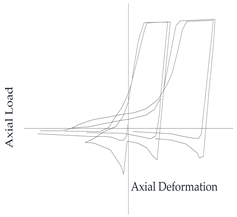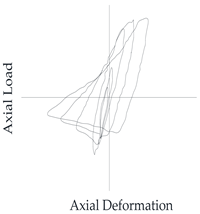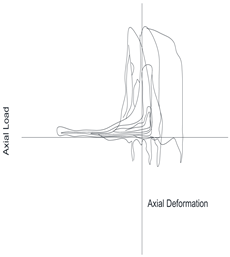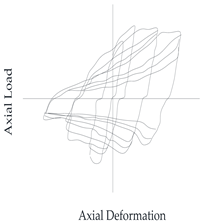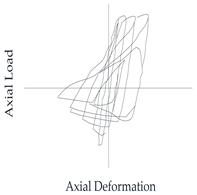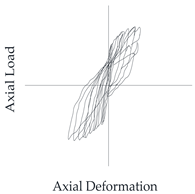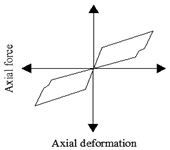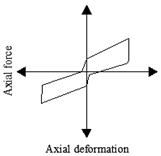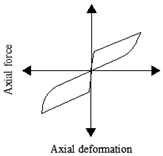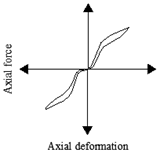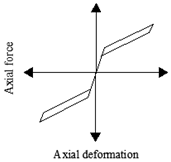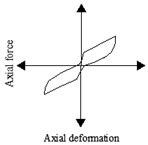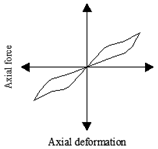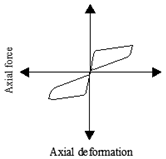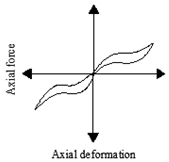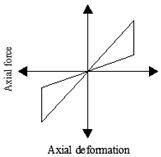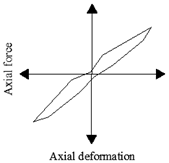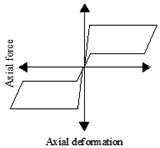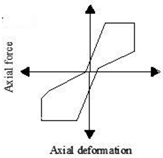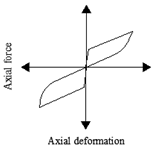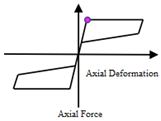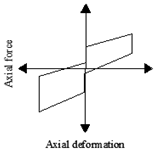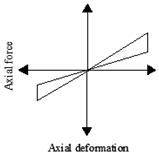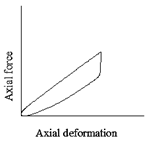Abstract
Steel braced frames resist earthquake ground motion by undergoing several cycles of inelastic deformation. These deformations include elongation under tension and buckling in compression. To facilitate an understanding of the inelastic response of concentrically braced steel members under cyclic loading, several experimental, numerical, and analytical studies have been carried out by various researchers around the world. To overcome buckling, one of the primary failure mechanisms in Concentrically Braced Frames (CBFs), different bracing systems with recently developed mechanisms were implemented to tackle this phenomenon. The main features of these systems are to dissipate the earthquake-induced energy effectively, with minimum damage to buildings and infrastructure. Such systems still have some drawbacks, such as weight, price and specific performance issues. This work comprehensively studies CBFs, including concept, design, seismic behavior and performance for conventional, modern, and self-centering bracing systems. It summarizes 27 test programs for conventional CBFs, highlighting the different alternatives and approaches used by various researchers. Several additional studies incorporating self-centering bracing systems are also emphasized. The work finally highlights the advancements and challenges in achieving more sustainable solutions for the built environment.
1. Introduction
Earthquakes are considered one of the leading natural disasters that can cause considerable losses to human lives and infrastructure. Structural engineers constantly try new ideas and apply creative techniques to reduce losses. In the past few decades, various techniques have been used in different structures, including, but not restricted to, moment-resisting frames, shear wall buildings, braced frames, base isolation, and others. Different design codes continuously provide better design guidelines that can result in improved performance for various types of structures. According to [1], structural steel is a prominent construction material, accounting for 58% of the non-residential and multi-story residential construction market in the United States for the year 2011. The nonlinear behavior of elements in steel structures dissipates energy in seismic events. Special Concentric Braced Frames (SCBFs) are primarily used for low-rise buildings in the United States, particularly in earthquake-prone areas [2]. Concentrically Braced Frames (CBFs) are one of the most effective lateral force-resisting systems. However, diagonal bracing members require careful attention after earthquakes, to assess their performance. The working mechanism of braced steel frames results in truss action, which exerts axial forces only on bracing members. The mechanisms dissipate energy by yielding in tension and buckling in compression [3]. CBFs are easy to design, dissipate energy efficiently and minimize non-structural damage, since concentric braces increase stiffness and reduce deformations in buildings. Some of these braces use rigid connections, which provide better inelastic performance. In fact, compression results in buckling and strength reduction of the brace element, which in turn depends on slenderness [4]. The higher the brace’s slenderness ratio, the less fracture life it experiences. Experimental tests showed that local buckling occurs at the brace mid-length upon inelastic buckling of the braces in compression [5]. Alternatively, the actual tensile resistance of a brace member is higher than the theoretical one, due to the reduction factors used in the design. Usually, a building experiences over-strength related to material effects, standard section sizes, and non-structural elements’ contribution, besides other sources contributing to reserve strength. On the other hand, the disadvantages of CBFs include low redundancy and rapid strength degradation.
Although steel bracings have simpler connections compared to moment-resisting frames, CBFs experience lower ductility. Buckling Restrained Braces (BRBs) were introduced to overcome the buckling problem in conventional bracing systems. BRBs are steel tubes filled with concrete and a steel core. BRBs are characterized by stable hysteresis in tension and compression. One of the main aspects of BRBs is that they have symmetric tension–compression behavior. Also, their strength and stiffness parameters can be adjusted independently. However, their major drawbacks are large cross-sections in tall buildings and high installation and maintenance costs. On the other hand, the Yielding Brace System (YBS) dissipates energy effectively and maintains members’ elasticity [6]. The latter system was introduced as an alternative and is a competitor for BRBs. Low-to-medium-rise steel frame buildings equipped with tension braces are also widespread. Recently, researchers started using smart materials to develop reliable bracing systems. One of the most-used smart materials is the Nickle-Titanium Shape Memory Alloy (Ni-Ti SMA), which comes in wires and rods. In many studies, SMA proved to be a promising alternative to conventional, and even modern, developed systems, due to its excellent performance in resisting cyclic loading.
This work summarizes 27 test programs conducted in previous studies, presenting 189 cyclic loading tests for Conventional Concentrically Braced (CCB) frames, highlighting the different alternatives and approaches used by different researchers. Additionally, several studies incorporating self-centering bracing systems are also summarized and presented. The latter group’s main aspects, advantages, and shortcomings have been emphasized. The aim of this work is thus to comprehensively study CBFs and the related research conducted during the past twenty years, including the working mechanism concept, the design of conventional bracings, and the seismic behavior and performance of conventional, modern, and self-centering bracing systems. Based on this comprehensive survey, the study concludes by emphasizing the advancements in and challenges for CBFs in arriving at a resilient built environment.
2. Literature Methodology and Statistics of Publications
After presenting statistical information for publications on CBFs, the methodology adopted in this study starts with classifying the bracing systems into different categories. Next, the design philosophy of bracing systems in building codes is presented. The inelastic seismic response of bracing systems is then discussed, and test results are summarized and presented. Highlighted studies for conventional, modern, and self-centering bracing systems are then presented in some detail. Comprehensive tables are generated for the different studies, discussions are presented, and conclusions are made.
Several engineering databases that collect and sort different types of publications, including journal papers, theses, and conference proceedings, have been thoroughly searched. The search was conducted for the years from 2002 until the date of this study. The year 2002 is selected in the present work as a continuation of a survey on the inelastic response of steel bracings conducted by Tremblay [4]. The tabulated survey by Tremblay [4] has been included in the present study, to provide the reader with an inclusive review. The conducted search showed that two-thirds of the publications since 2002 were journal articles, at a percentage of 71%. The other third was mainly published in conference proceedings, at a percentage of 26%, including papers and reviews, while the remaining 3% comprised reviews and book chapters. Figure 1 depicts the number and type of publications conducted in this area of research from 2002 to 2023. Notably, the number of studies is increasing with time, especially for journal papers. While the number of publications stood at 2 in 2002, it rose dramatically in twenty-one years to around 745, with an Annual Growth Rate (AGR) of 18% from 2002 to 2012 and 51.5% from 2013 to 2023. The numbers shown draw attention to the great emphasis this area of research attracts.
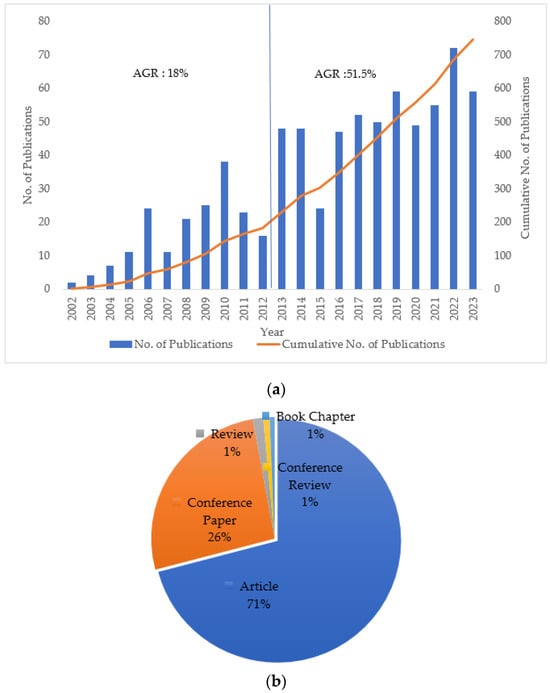
Figure 1.
Statistics of publications on concentrically braced frames since 2002 (a) Number of publications over the years (b) Type of publication.
Similarly, statistics of publications conducted on CBFs in different countries are extracted and presented in Figure 2. The United States leads, with 191 publications. With more than 100 publications, Iran, Canada and China come next, while other countries produced less than a hundred publications. One can relate these numbers to the available resources and interest, along with the seismicity of the country.
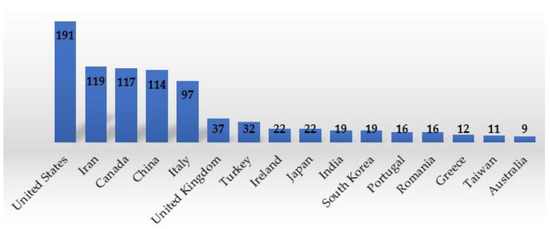
Figure 2.
Number of publications in different countries.
3. Classification of Braced Frames
Bracings can be classified into many categories, based on the type of classification. As time passes, researchers tend to try new techniques, materials, configurations, ways of testing, and design approaches. In this review study, bracing systems are classified based on three main approaches: the Material, Configuration, and Mechanism classification. The flow chart shown in Figure 3 shows the mentioned classification approach.
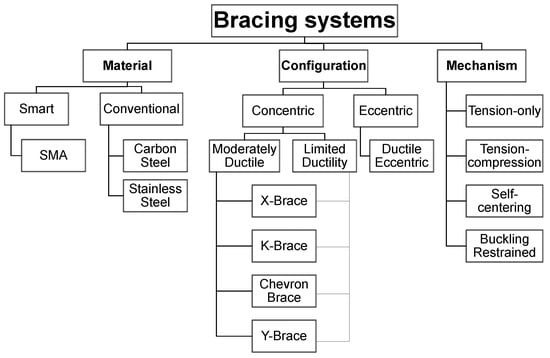
Figure 3.
Different classification categories for bracing systems.
3.1. Material-Based Classification
In construction projects, various materials are utilized to create load-bearing structural systems. These materials typically encompass options such as structural steel, concrete, masonry, wood, or a strategic combination of these, to achieve an efficient building design. For a significant proportion of commercial and industrial buildings, structural steel or reinforced concrete serve as primary choices for essential structural components like columns and beams. In the process of structural design, engineers must carefully determine which material, and sometimes which combination of materials, is most appropriate, based on a range of factors.
The selection of construction material hinges on numerous considerations, with cost often exerting significant influence. However, other factors like weight, strength, ease of construction, material availability, sustainability, and fire resistance also play pivotal roles in this decision-making process. For the context of bracing systems, various materials have been employed over time to fabricate these systems. This section divides bracing systems into two categories, based on the material utilized, as depicted in Figure 4. The conventional category includes widely used materials like Carbon Steel and Stainless Steel. Previous studies in this field predominantly utilized Carbon Steel, while a few also incorporated Stainless Steel [7].
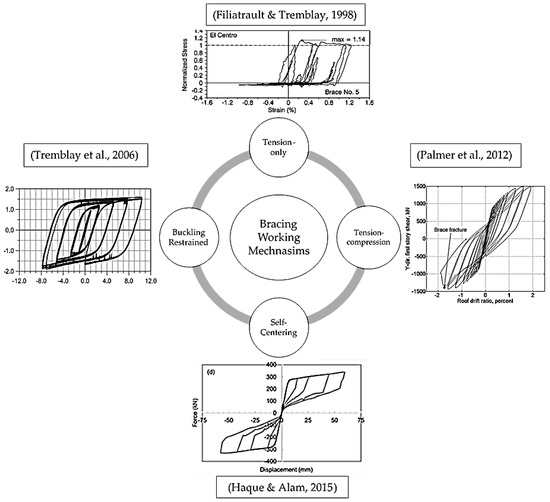
Figure 4.
Samples of different bracing systems, based on the working mechanism [2,8,9,10].
Secondly, researchers recently started developing new bracing systems in light of the so-called smart materials. In structural engineering, this category mainly consists of Shape Memory Alloys (SMA). Simply written, SMAs are alloys that can gain their original shape after removing the load (super elasticity) or heating (shape-memory effect). They can be in different material compositions and percentages, such as Nickle-Titanium, and many others. One of the major concerns for engineers when lateral loads are induced into a building is to minimize the residual deformations, to ensure the continuous operation of the building, especially the essential ones such as hospitals. Employing SMA material in the bracing system will minimize these deformations, resulting in better seismic performance and safer buildings.
3.2. Configuration-Based Classification
This work follows the classification of bracing systems based on the guidelines set by [11]. As per these guidelines, braced frames fall into two primary categories: Concentrically Braced Frames (CBFs) and Eccentric Braced Frames (EBFs). Within CBFs, there are further subdivisions of Moderately Ductile (MD) and Limited Ductility (LD) frames, while EBFs belong solely to the ductile category.
Generally, moderately ductile CBFs have the capacity to dissipate moderate amounts of energy through the yielding of bracing members. However, knee bracing and K-bracing, including systems where pairs of braces meet a column on one side between floors, do not fall within the definition of moderately ductile concentrically braced frames, according to [11].
On the other hand, CBFs of limited ductility are capable of dissipating only a restricted amount of energy, through the yielding of bracing members. Both ductility categories have specific criteria that must be met to classify a braced frame, accordingly. These requirements encompass factors like allowable story levels, brace slenderness, and bracing connections. Table 1 provides a concise comparison, illustrating the aforementioned requirements for each category.

Table 1.
Different requirements for MD and LD CBFs, according to Canadian standards.
3.3. Working Mechanism-Based Classification
The seismic force dissipation of bracing systems is intricately linked to their specific working mechanisms. In this study, CBFs have been categorized into four distinct classes, based on their operational mechanisms: tension only, tension–compression, buckling restrained, and self-centering bracing systems. The first category, tension-only bracing systems, is typically limited to specific heights and regions of low seismic activity. These systems mainly employ steel rods to dissipate tension cycles, exclusively. Due to their nature, they have inherent restrictions on their application.
The tension–compression category is the most prevalent system observed in CBFs. It encompasses a wide range of structural steel shapes, including WWF, W, and HSS sections. Much of the existing research focuses on this category, exploring both member behavior and connection details. The BRB, a standout in the realm of seismic load-resistant bracing systems, is the third category. This innovation was developed by [12] and was initially manufactured and distributed by Nippon Steel Corporation. BRBs consist of a concrete or grout-filled steel tube enveloping an inner steel core. Under cyclic loading conditions, BRBs exhibit stable bilinear hysteresis loops, showcasing exceptional energy dissipation capabilities highlighted by the substantial area enclosed within their hysteresis loops. This system has gained global recognition and widespread usage.
Lastly, the fourth category is the self-centering bracing system, a relatively recent development. This system capitalizes on smart materials, such as SMA, for their inherent self-centering attributes. In these systems, SMA bars or wires are central components responsible for carrying loads and absorbing seismic energy. Generally, self-centering bracing systems exhibit stable and repeatable behavior and display a flag-shaped hysteresis response, emphasizing their efficacy in seismic scenarios. Figure 4 offers a visual representation of the classification of bracing systems based on their distinct working mechanisms, providing a comprehensive overview of the categories discussed.
4. Design of Concentric Braced Frames (CBFs)
Modern building codes, such as [1,11,13,14,15], have established a diverse range of specialized seismic design procedures. These procedures are meticulously outlined to ensure that steel frames meet specific criteria for global performance and ductility, safeguarding against uncertain or subpar seismic performance. These codes prescribe seismic load-resisting systems that calculate design forces for various structural elements. The utilization of seismic-resistant systems with questionable performance is generally limited or prohibited in certain applications.
In the context of steel structures, Lateral Force Resisting Systems (LFRS) assume a crucial role in design. These systems encompass both braced and unbraced frames, with the latter being referred to as Moment-Resisting Frames (MRFs). However, the focus of this review is on braced frames. Design requirements for seismic scenarios differ, depending on the configuration of the bracing. For the achievement of ductile behavior in braced frames, seismic codes typically define two distinct zones: dissipative and non-dissipative.
In the context of braced frames, this review concentrates on the concept of “capacity design”, which is central to achieving structural resilience and performance. This concept is discussed in [16], and is illustrated in Figure 5. The underlying principle of capacity design involves ensuring that the structural components adjacent to the dissipative members possess greater resistance than the dissipative elements themselves. This strategic arrangement averts elastic instabilities and brittle failures outside the dissipative zones.

Figure 5.
Capacity design concept.
Additionally, this approach guarantees that these components maintain elastic and stable behavior during overall deformations, enhancing the overall seismic performance and integrity of the structure. It is noteworthy that the in-series chain system shown in Figure 5 helps describe the capacity design concept rather than its actual application, as the inelastic response of structures under seismic loads may involve both parallel and series modes of failure, in addition to other aspects such as the load redistribution, which are better represented by a transportation network [17].
Another essential feature of the ductile behavior of steel structures is the number of formation of plastic hinges; less-ductile systems possess low numbers of plastic hinges, whereas more plastic hinges can be observed in high-ductile resisting systems. For example, frame structures are assumed to be more ductile than bracing systems, as they possess more plastic hinges. The plastic hinge formation is related to the behavior factor of the structural type, by means of energy dissipation. In order to pre-define the location of the hinges to be formed in the frame for reliable mechanisms, the concept of strength hierarchy, using the chain analogy method of [16], best explains it.
The concept of capacity design in structural engineering aims to ensure controlled failure during extreme events like earthquakes. This involves designing structures so that specific components dissipate seismic energy, while others remain elastic. The analogy of a chain (Figure 5) with ductile and brittle links illustrates this [16,18]. Ductile elements absorb energy and deform before failing, acting as sacrificial protection. To account for uncertainties in material strength and other sources contributing to the ductile element’s actual strength, other links are designed to be stronger than the ductile element. This approach is crucial in seismic design, preventing catastrophic collapses. References like [19,20,21,22] and others offer insights and case studies on applying capacity design principles in building design, especially for seismic-resistant systems.
4.1. Canadian Standards
The CSA S16-14 [11] guidelines delineate two distinct categories for concentrically braced steel frames: MD and LD braced frames. Both systems achieve energy dissipation by allowing braces to yield in tension, and, to a lesser extent, by permitting flexural hinging in braces when they buckle under compressive forces. While both categories adhere to a rigorous capacity design procedure, they share similar design and detailing rules. However, some concessions are granted for the LD system. Once brace buckling occurs during intense seismic activity, the seismic response of CBFs primarily hinges on tension-acting braces. As per the regulations in [11], it is stipulated that braces along a given braced line should be positioned to provide comparable story shear resistance, through tension-acting braces in opposing directions. This stipulation allows design engineers the flexibility to opt for either a tension-only or a tension–compression braced frame design, selecting the most economically viable approach.
The NBCC [23] introduces height restrictions that vary, based on the selected braced frame type in the design. Smaller height limits are implemented for tension-only bracing, due to the typically slender braces associated with this design approach, which exhibit limited energy-dissipation capability. Conversely, taller structures are permitted when adopting LD frames, recognizing their capacity to endure lower inelastic demand, thereby reducing vulnerability to soft-story responses. The brace’s effective slenderness parameter, KL/r, is generally capped at 200 for all systems, except for tension-only LD braced frames in one- and two-story buildings, where it extends to 300. Prior research into bracing members subjected to cyclic inelastic axial deformation has indicated that brace fracture life decreases as slenderness diminishes [4]. CSA-S16-14 [11] specifications align with this observation, by introducing stringent width-to-thickness ratio limits for braces with KL/r equal to or less than 100, with these limits gradually relaxing for KL/r values between 100 and 200. Test programs on hollow structural section (HSS) bracing members with low slenderness have demonstrated that they might lack adequate ductility capacity to withstand anticipated inelastic demands.
The Canadian Standards [11] introduce a requirement that HSS braces must have a minimum effective slenderness of 70, to prevent premature fracture. In this standard, verifications must consider the effective brace slenderness, accounting for intermediate support conditions and the actual fixity at the brace ends. When conducting capacity design, components of LFRS other than the braces need to withstand the forces that arise when the braces approach their potential axial resistance. The Canadian Standards [11] present new definitions for various parameters related to brace resistance. The possible brace tensile resistance, Tu, is defined as Tu = ARyFy, where A represents the brace’s cross-sectional area and RyFy is possible yield stress. The probable brace compressive resistance, Cu, is the smaller value between ARyFy and 1.2 times the brace buckling resistance, calculated with a resistance factor φ = 1.0 and the possible yield stress, RyFy. Additionally, the potential post-buckling brace compressive resistance, C’u, is defined as the lesser of 0.2 ARyFy and Cu. These definitions and calculations provide a comprehensive framework for assessing the structural behavior of braces and their capacities within the standard.
4.2. American Standards
ANSI/AISC 341 [1] classifies braced frames into four categories: Ordinary Concentrically Braced Frames (OCBF), Special Concentric Braced Frames (SCBF), Eccentric Braced Frames (EBF), and Buckling-Restrained Braced Frames (BRBF). SCBFs are engineered to endure substantial inelastic deformations during design-level earthquakes, while OCBFs are intended to withstand limited inelastic deformations. In regions with low seismic activity, ASCE/SEI 7 [24] permits steel framing systems to be designed with a Response Modification Factor, R, of 3.0, without necessitating special detailing to enhance ductility. ASCE/SEI 7 [25] allows for both OCBFs and SCBFs. However, SCBFs are designed with larger R factors, anticipating considerable inelastic deformations during intense seismic activity.
Typically, SCBFs are designed to achieve an inelastic deformation of around 2.5% story drift before brace failure. To ensure this desired inelastic deformation, ductile detailing and proportioning guidelines are implemented for SCBFs. These structures experience inelastic flexural deformations in beams, columns, and connections during substantial seismic motions. While the inelastic deformations in beams and columns are not primary design objectives, they significantly impact the seismic performance of SCBFs, and influence repair costs. ANSI/AISC [1] mandates local slenderness limits for beams and columns to account for these localized inelastic deformations, acknowledging their influence on structural behavior.
4.3. Eurocode
Concerning the design methodology, Eurocode [14] introduces both non-dissipative and dissipative design behavior. Generally, the dissipative approach is more cost-effective. Earthquake-resistant steel structures in Eurocode 8 are classified into three ductility classes, based on member ductility: low (DCL), medium (DCM), and high (DCH). Two distinct design approaches can be employed. In the first approach, where low energy dissipation is expected, internal forces are assessed using elastic analysis, corresponding to structures in the low-ductility class (DCL). A q-value exceeding 1.5 is prohibited here, implying almost elastic behavior. The second approach acknowledges a structure’s capacity to withstand earthquakes through inelastic member behavior. In this case, structures should belong to the DCM or DCH ductility classes, and q-values above 1.5 are permitted. The behavior factor (q) is determined for medium- and high-ductility class structures, based on structural type and ductility class (summarized in Table 2). Larger q-values are assigned to structures with a higher propensity for strong dissipative behavior (such as MRFs) and high-ductility members.

Table 2.
Behavior factor q stated in EC8 for regular steel buildings.
Eurocode 8 classifies CBFs into two categories, by configuration: diagonally-braced frames (X-CBFs) and chevron-braced frames (V-CBFs). Different design criteria and q-values are specified for these two types. In frames with diagonal braces, compressive braces are disregarded, and strength is estimated using the yield strength of tension braces. For chevron-braced frames, both tension and compression braces are considered, and strength is estimated based on the buckling strength of all braces. For DCH and DCM ductility classes, q-values are set at 2.5 and 2.0, respectively, for chevron-braced frames. Frames with diagonal braces can be designed with q equal to 4.0 for both DCH and DCM classes. It is important to note that there is no distinction between X-CBFs in DCH and DCM ductility classes, as they follow the same criteria and q-value. The reduced q-values for V-CBFs can be justified by considering their post-buckling behavior. In chevron-braced frames, buckling occurs in compression braces when the story shear force reaches the design value. Due to reduced axial strength in compression braces during post-buckling, the frame’s story shear strength might fall below the design value. A study was performed by Elghazouli [26], in which bracings were designed and detailed according to Eurocode 8, which indicated that the tension design approach produces higher ductility demand than the compression design. It was also observed that irregular deformation existed, due to asymmetric compression and tensile behaviors of the brace members. It was concluded that balanced brace capacity over building height yields better inelastic demand distribution.
4.4. Building Code of Japan
The Japanese building code [15] classifies steel structures based on the ductility of their structural members. It identifies four classes for moment-resisting frames (FA, FB, FC, and FD) and three classes for braces (BA, BB, and BC). The first letter in the class name indicates the structural type: “F” for moment-resisting frames, and “B” for braces. The second letter indicates the ductility of the members: “A” for high ductility, “B” for good ductility, “C” for fair ductility, and “D” for poor ductility. The determination of ductility class depends on criteria like the width-to-thickness ratio of beams and columns for moment-resisting frames and the slenderness ratio for braces. In the case of moment-resisting frames, the BCJ introduces a structural characteristic factor (Ds) that varies with member ductility. The smallest Ds value (0.25) corresponds to the most ductile frame (FA). Larger Ds values are required for frames with lower member ductility.
Braced frames in Japan are typically combined with backup frames that possess significant seismic strength and stiffness. This differs from North American and European practices, where braces are integrated into gravity-supporting frames. Consequently, Ds values specified in the BCJ for braced frames depend not only on the ductility of the braces (brace class), but also on the ductility of the backup frame (frame class) and a parameter called “β”, which is the ratio of the shear sustained by the braces to the total shear strength (see Table 3, in the code). The classification of braced frames in the BCJ also takes into account the ductility of the braces themselves. The smallest structural characteristic factor Ds is specified for frames with short braces (BA), because they exhibit the most dissipative and stable inelastic behavior. In contrast, larger Ds values are prescribed for frames with longer braces falling into the BB and BC classes.

Table 3.
Structural characteristic factors Ds stated in BCJ.
4.5. Chinese Code
The Chinese Code [7] strongly advocates the use of dual systems involving CBFs in seismic design, particularly for tall buildings. This approach combines the moment and braced frames’ respective rigidities, to collectively resist seismic forces. Through numerous analytical and experimental studies, logical and sequential energy-dissipation patterns have highlighted the favorable attributes of dual systems.
When brace buckling occurs, the yielding and subsequent post-buckling behavior of braces becomes a primary source of energy dissipation. The global flexural buckling of braces can also induce local buckling. With repeated cycles of significant axial plastic deformations, tears may develop in localized buckling zones of braces, resulting in a significant decrease in the structure’s strength and stiffness. Consequently, the flexural yielding of beams and columns emerges as a vital means of strength provision and energy dissipation, particularly at high levels of drift.
The Chinese Code, in addition to prescribing ductile behavior for bracing members and their connections, also mandates adequate ductility in moment frames. This extends to the beams, columns, and their connections. The code stipulates that moment frames should have the capability to withstand the greater of the following two conditions on each floor: (i) the smaller of 25% of the total factored base shear force of the building under the design earthquake and 1.8 times the maximum factored seismic story shear force on each story, and (ii) 1.15 times the seismic force carried by the moment frame on each story. The second condition ensures that the moment frame’s resistance is enhanced, even if the requirements of the first condition are satisfied. This provision enables the use of CBFs with dual systems in significantly taller buildings, as indicated in Table 4 of the Chinese Code. The height limitations decrease from 220 m to 120 m with increasing seismic fortification intensity (akin to the design ground acceleration in the Canadian Code—IEFaSa (0.2). It is notable that the height restrictions in the Chinese Code are notably more stringent, compared to the Canadian Code.

Table 4.
Height restriction for LFRS of braced frames specified in design Codes.
5. Inelastic Seismic Response of Braced Frames
The design of tall buildings is governed by the lateral forces generated by earthquakes or wind loads. Braced frames are considered one of the most efficient techniques to resist these lateral forces in the two orthogonal directions of steel structures. The main objective of a bracing system is to resist horizontal shear-induced on the structure because of the lateral forces. One should follow the horizontal shear path along a frame, to understand the horizontal-shear-resisting mechanism. It can be illustrated by considering the four types of bracings (i.e., diagonal, K-bracing, and eccentric) subjected to lateral loading. Figure 6 shows a typical horizontal shear path with the brace hinging, after successive tension and compression cycles [4].

Figure 6.
Inelastic response of chevron braced frames.
Researchers have conducted numerous experimental and numerical studies on bracing systems, including many tests and simulations. Various configurations and loading procedures have been adopted to comprehensively understand the behavior of the bracing system, and the braced frame building in general, during lateral movement of structures. The previous studies are summarized and presented in Table 5. The summary includes the number of specimens tested in each study, the shape of the tested specimens, the end connection type, the axis around which the test was performed, the type of the observed buckling, the steel grade used, the cross-sectional area of the specimen Ag, the yield strength, Fy, the width-to-thickness ratio normalized to the code limit, the effective length of the specimen, LB, the full length of the specimen, LH, the slenderness parameter, λ, the yield deformation, δy and the displacement history used to conduct the test, as shown in Figure 7.

Table 5.
Characteristics of the conventional bracing specimens in previous tests.
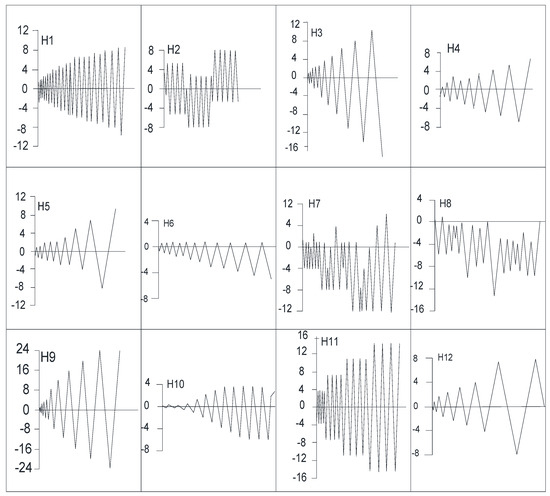
Figure 7.
Typical loading histories.
5.1. Conventional Braced Frame
More than 27 experimental studies have been previously conducted on different sizes and shapes of conventional bracings, and are summarized herein, as shown in Table 5. Various response parameters can be obtained and compared, as seen in the table and shown in the following sections.
5.1.1. Specimen Details
The conducted studies encompassed a range of tests on bracing members with different cross-sections, including Hollow Structural Sections (HSS), pipes, I-sections (W, UC, and H), T-sections (WT), back-to-back angles (2-L), and back-to-back channels (2-C). These cross-sections featured dimensions spanning from 20 to 250 mm, with tensile yield strengths (AgFy) ranging from 40 to 2346 kN. The normalized width-to-thickness ratio covered a spectrum from 0.19 to 1.72.
The brace’s effective slenderness ratio (KL/r) was assessed within the buckling plane, considering the relevant end conditions. As outlined in Table 5, the brace length (LB) of specimens spanned from 985 to 4850 mm. Axial deformation (δy) was computed as the product of the brace’s clear length (LB) and its yield strain (εy = Fy/E), where E equals 200,000 MPa, leading to δy values ranging from 1.1 to 14.6 mm, depending on specimen length. The slenderness parameter (λ), defined in Archambault et al. (1995) [41], encompassed values between 0.31 and 2.91.
5.1.2. Loading Histories and Brace Performance
The test programs utilized various displacement histories, as depicted in Figure 7. These loading patterns should be regarded as representative examples, as there could be slight variations in the actual history between specimens within a given group. The majority of tests employed cyclic quasi-static loading, with a few implementing real earthquake records. Generally, displacement patterns were symmetric or nearly symmetric, with alternating increases in tension and compression excursions at each cycle or every second cycle. Pattern H2 was derived from nonlinear dynamic analyses of building structures, featuring X-bracing’s axial deformations over time. Loading protocols H7 to H9 were developed to emulate the demand on bracing members in chevron bracing with weak beams, involving substantial compression ductility demand and limited tension ductility demand (refer to Figure 7). Pattern H8 was adopted from analysis results.
5.1.3. Sample Studies
In the research conducted by Shaback and Brown in 2003 [3], the authors conducted a detailed examination of nine square Hollow Structural Section (HSS) specimens, subjecting them to testing, until failure. These specimens were equipped with gusset plates at their end connections, with the free length of the gusset plates varying from 1.25 to 2 times the thickness of the gusset plate material. The tests involved applying compression and tensile forces, as well as elastic cycles for calibration purposes. The study highlighted the fact that plastic rotation at the gusset plate and central specimen hinges played a significant role in causing out-of-plane deflection. Additionally, while the width-to-thickness and slenderness ratio had a lesser impact, the study presented a lateral displacement equation, based on ductility. Contrary to code suggestions, the specimens exhibited substantial degradation in compressive strength during subsequent cycles, shedding light on the importance of addressing low-cycle fatigue in HSS braces. The factors influencing low-cycle fatigue included width-to-thickness ratios, slenderness, width-to-depth ratios, and mechanical properties of the brace. The study generated hysteresis loops for all braces that displayed compressive strength degradation.
In a related study, the authors conducted a comprehensive series of experimental tests on brace specimens made from Hollow Structural Sections (HSS). These specimens were designed and tested according to various standards and codes, with a thorough description of the experimental setup provided, along with clear comparisons. While the study yielded valuable conclusions, the authors suggested that further investigations could be beneficial, to validate and expand these findings. This could involve comparing experimental results with numerical simulations, to enhance the study’s novelty and comprehensiveness. Among the key conclusions drawn from this research, a noteworthy observation aligned with the findings of Tremblay et al. in 1996 [42], which identified out-of-plane buckling as a primary cause of non-structural damage in buildings, resulting in significant financial losses and extended repair times.
To address the issues mentioned above, Palmer et al., in 2012 [2], conducted three tests on Special Concentrically Braced Frames (SCBFs), designed using a balanced design procedure. These tests included two planar frames and one 3D frame, with a tension brace supporting the compression brace, to prevent out-of-plane buckling. The results revealed that an effective length of 0.5 provided a good prediction of buckling strength for compression members. In alignment with the balanced-design-procedure approach, yielding was observed in gusset plates, rather than in different frame members such as columns and beams. Damage was predominantly limited to beam flanges near the column connection, with panel zone yielding not formed, which led to deformation and load redistribution. This redistribution proved beneficial in preventing stress concentration in specific regions. The study compared two planar frames with a 3D frame, and conducted tests on damaged frames, until failure. Tension members showed consistent original capacity, whereas compression members exhibited a 40% reduction in capacity. Furthermore, bi-directional load demand had a lesser impact on frame performance. The study’s large-scale tests, which are relatively scarce in this field, emphasized the advantages of the design approach, which is not widely used.
In a study by Goggins et al. in 2006 [40], rectangular and circular cold-formed steel sections were investigated, to understand the behavior of concentric braces. The study utilized a displacement-controlled Eurocode loading protocol, applied based on axial yield deformation. Tensile tests on coupon and short specimens were conducted to measure material strength, highlighting the fact that cold working of cold-formed steel could locally increase tensile strength. The study involved cyclic axial displacement tests for two specimens, resulting in observations of uniaxial and biaxial buckling. Notably, stouter specimens exhibited greater capacities than slender ones, but also experienced higher compressive strength degradation. Additionally, specimens with higher yield strength displayed lower ductility demand and greater energy dissipation, while those with higher slenderness ratios presented higher ductility demand and lower deformations. Surprisingly, the width-to-thickness ratio did not significantly affect ductility demand. In the later stages of loading, the results indicated an increase in deformation during the post-buckling range of the tested specimens.
The authors conducted extensive experimental work that encompassed various cross-section sizes and shapes, adding substantial value to the study. To enhance the study’s value further, the findings could benefit from support through numerical simulations. It is also worth noting that this research paper is linked to the work by Lucas, in 2003 [43], incorporating some of the test setups and initial test results from the latter paper, which featured a broader range of specimens and tests.
As one of the most extensive studies, Tremblay et al., in 2008 [44], designed and tested 34 cold-formed rectangular, W-shape and circular steel specimens, varying in width-to-thickness ratios. The study predominantly assumed out-of-plane buckling during the design process, which is a common and significant concern in real-life applications. The tests were conducted using a quasi-static load, and pre-tensioned high-strength bolts were used at the end connections, to secure the grip of the testing frame. Displacement-based loading protocols were applied to simulate inter-story drift derived from actual earthquake records. The tests revealed tensile axial yielding and global buckling compression cycles in all specimens. Circular specimens experienced local buckling, while W-shape specimens encountered global buckling around their weak axis. Rectangular specimens, in line with prior findings, sustained repeated cycles with better tension performance than compression. Maintaining similar slenderness and width-to-thickness ratios for rectangular and circular specimens resulted in a comparable performance between the two categories. Notably, fractures in rectangular and circular specimens occurred after local yielding. This extensive study, featuring a substantial number of experimental tests and a diverse array of cross-section shapes and sizes, enhanced the research’s applicability, by closely simulating real-world scenarios. Moreover, it built upon the outcomes of a prior study by Tremblay et al. in 2003 [38], aiming to reinforce and validate earlier findings in the realm of seismic design for braced frames.
In a study conducted by Elghazouli, in 2003 [26], nonlinear static and dynamic analyses were employed to illustrate the design aspects of braced frames. The pushover test was displacement-controlled, with tension braces yielding at approximately 0.4% drift. Dynamic analysis was based on a real earthquake record. The results indicated that the tension design approach imposed higher ductility demand, compared to the compression design. Irregular deformation patterns were observed, due to the asymmetric compression and tensile behaviors of the brace members. The study concluded that balanced brace capacity across the building height resulted in a more even distribution of inelastic demand. Various slenderness parameter values were considered and investigated.
Elghazouli et al., in 2005 [5], conducted shake-table tests on two hollow-brace specimens, to gain further insights into the behavior of braced frames. The specimens’ end connections were rigidly connected, with a 200 mm spacing between specimens, to prevent contact during testing. Cold-formed hollow square/rectangular sections were employed, with small section sizes chosen to comply with shake-table limitations. Coupon and tensile tests measured material strength before the shake-table tests, which were conducted with different scaling factors, using selected real earthquake records. The cyclic response of brace elements exhibited both tensile yielding and compressive buckling. The study found that the use of idealized scaling for the seismic records led to symmetric responses, although minor asymmetric responses were noted in some specimens, due to uncertainties in the natural records used. Notably, tensile capacity was reduced by 30% when considering actual yield strength, and ultimate capacity was only 10% less than actual yield capacity. Additionally, maximum shear force was found to be 10–30% and 20–60% higher than ultimate and yield capacities, respectively. Brace cross-section and slenderness parameters significantly influenced performance, with low-slenderness specimens and high width-to-thickness ratios experiencing earlier failure.
The authors conducted robust experimental tests using a shake table and natural earthquake records, which is a notable distinction, as most similar tests in this research area rely on quasi-static loading. While the use of reduced-scale specimens was necessitated by the shake table’s capacity limitations, a consideration of the scaling procedures could further enhance the study’s reliability. Additionally, the authors compared their results with previous reviews conducted by Tremblay in 2002 [4], highlighting the consistency of conclusions between the two studies, reinforcing the soundness of the performed tests. Table 6 summarizes the main findings and sample results for the above studies.

Table 6.
Main findings and sample hysteretic behavior for various experimental tests on CBFs.
5.2. Modern Braced Frames
As mentioned previously, conventional bracing systems have some drawbacks that result in substantial monetary losses, since, after a major earthquake, many buildings sometimes need repair or demolishing and rebuilding. As buckling of the brace members is one of the main failure criteria, researchers developed new systems to overcome this issue. The developed BRB by Takeuchi et al. [12] is one of the most-used systems. Tremblay et al. [8], in their research study, used six full-scale tests, which were prepared and conducted on BRBs and conventional braces, for comparison purposes. The test specimens were designed according to the Canadian provisions for strain demand (NBCC, 2015) [23]. Test specimens were mounted horizontally on the strong floor, and rigid connections were selected to ensure brace yielding. Different core lengths were incorporated into the BRB specimens, to study their effect on the performance.
Moreover, previously introduced concrete-filled cores and newly proposed steel-restrained cores were tested. To allow steel core yielding in tension and compression, unbonding filling material was used. Both quasi-static and dynamic loadings were selected and applied. The first six cycles were used to determine the initial stiffness of the different specimens. Additionally, tensile tests on the steel core were carried out to determine its yield and ultimate strength. As predicted, BRBs showed a symmetric hysteretic response. It was found that shorter core specimens showed higher strain demand than their longer counterparts. Although dynamic loading was found to be less critical, the strain demand was higher in terms of low-cycle fatigue, compared to quasi-static. Finally, when compared with the BRBs, the conventional brace withstood the entire loading protocol, but showed poor energy-dissipation ability. A typical BRB hysteresis behavior is shown in Figure 8.
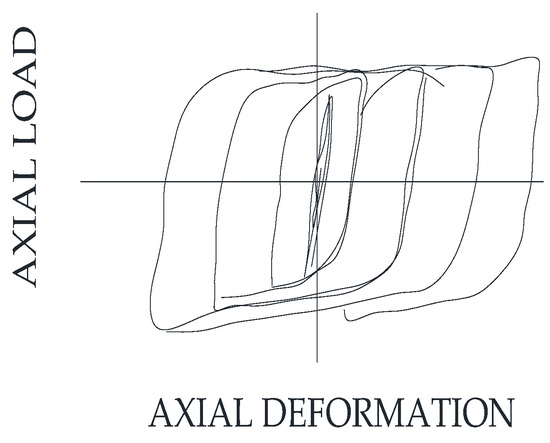
Figure 8.
Lateral load—core strain response in specimens.
In addition to the conducted experimental studies, Veismoradi, et al. [45] conducted a numerical one. In the mentioned study, two groups (i.e., BRB and YBS) were incorporated, using different building heights. Large stiffness capacities were assigned to members, to ensure fuse yielding in YBS. Two-dimensional frames were modeled to simulate 3D regular buildings, where Eigenvalue analysis was conducted to calculate natural frequencies and pushover analysis was performed to calculate post-yield stiffness. In general, YBS showed higher base shear, compared to BRBs. Moreover, Incremental Dynamic Analysis (IDA), using 22 earthquake records, was also performed. For performance criteria measurement, Immediate Occupancy (IO), Collapse, Prevention (CP), and Global dynamic Instability (GI) limit states were used. The results showed that low-rise YBS buildings had higher capacity. Performance-based earthquake engineering was adopted to capture uncertainty in the IDA. Taller buildings showed a higher probability of exceedance of different limit states. In the immediate-occupancy limit state, structures behaved linearly. The results concluded that 90% assurance of performance objective was achieved using Engineering Demand Parameter-Based and Intensity-Measure-Based states.
The research mentioned above included extensive numerical modeling and analyses. The validation of the developed numerical models for the BRB and YBS is accurate. However, validating the developed 2D models could be essential to support the study’s outcomes, as shown in previous studies [46]. More insights into the pushover analysis results would also be recommended. In order to obtain accurate numerical simulations and results, the outcomes shown are based on previous experimental data presented by Gray, Christopoulos and Packer [6]. This study on BRBs, like many others, shows this system’s good performance in terms of seismic resistance and efficient energy dissipation. Nonetheless, a potential drawback identified for BRBs is their tendency to exhibit considerable residual deformation, following simulations of maximum considered earthquake (MCE) and design basis earthquake (DBE) scenarios. These substantial residual drifts could present significant challenges when it comes to restoring buildings equipped with BRB Frames to their functional condition, after experiencing a major seismic event.
BRBs are known for their limitation with respect to post-yield stiffness, which is a significant drawback. To address this, a modification by reducing the yielding segment of BRBs was introduced. This new configuration involves dividing each brace element into two parts: (1) a yielding segment and (2) an elastic segment. Ref. [47] conducted an assessment of the probabilistic seismic performance of BRBs with reduced yielding segments, comparing them to conventional BRBs. They considered frames with different numbers of stories (3, 6, 9, and 12) using a 5 m bay length and two types of BRBs: conventional, and those with reduced yielding segments. These frames were designed in both chevron inverted-V and diagonal configurations. Using OpenSees, the frames were modeled for IDA and subjected to 17 ground motion records. The results indicated that the reduced-length BRBs exhibited higher spectral acceleration (Sa) capacities, lower probability of exceedance, and reduced potential-hazard probability for IO limit states when compared to conventional frames.
Similar to BRBs, another highly ductile bracing system is the yielding brace, often commercially referred to as the scorpion yielding brace. The hysteresis response of the brace is shown in Figure 9. In this system, seismic energy dissipation occurs through yielding fingers of specially engineered cast-steel connectors. When subjected to severe compression and tension loading, the fingers yield in flexure, thereby enabling the provision of a fully symmetric hysteresis behavior. A full-scale quasi-static testing of the yielding brace was conducted. This system shows stable hysteresis response up to a deformation range. After this range is exceeded, the hysteresis drastically degrades. It can also be observed that this bracing system has almost no self-centering capability. It should also be noted that the maximum displacement achieved by this brace is around 75 mm, which is approximately 1% of the brace axial deformation [6].
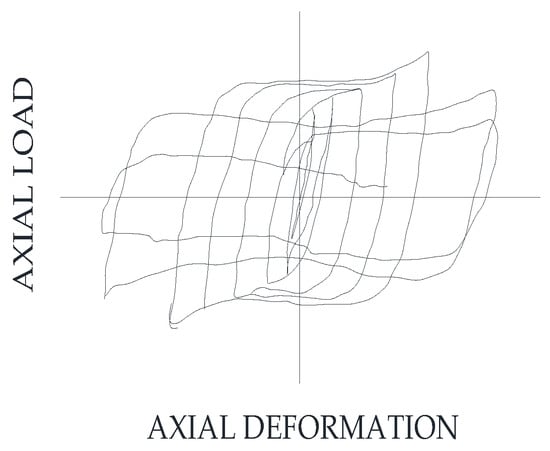
Figure 9.
Hysteresis of the full-scale yielding brace.
5.3. Self-Centering Braced Frames
In recent years, technologies have been evolving rapidly. Material-wise, newly developed materials have been developed to be equipped with various engineering applications to provide better performance and a better quality of life. One of the smart materials which has been newly developed is SMA. This alloy has the property of regaining its original shape after releasing the applied load. Such a property is of great importance for many applications, and, properly on top when it comes for structural applications in buildings. Araki, et al. [48] employed Cu-Al-Mn SMA to overcome the drawbacks of Ni-Ti wires, which include higher costs and machining difficulties. Shake-table tests, with a proposed stopper, were conducted to simulate the response of a two-story steel building. The designed base shear was 20% higher than the typical value.
Tests were conducted with and without the stopper, for comparison purposes, where it activates when a specific deformation value is reached. Activation of the stopper prevented the buckling of the SMA bars, as they have a negligible compression capacity. A simple finite-element model, neglecting the stopper, was developed. Simulation results showed good agreement with the experimental data. Further simulations, including extra earthquake records, were performed to ensure the reliability and efficiency of the proposed system. The authors in this study presented a novel tension brace, employing a relatively cost-effective method. The proposed system shows very good seismic performance. Although the proposed stopping mechanism showed good results, it complicated the entire system. The finite-element model was effective in predicting the seismic performance of the proposed system. However, its simplicity, including ignoring the stopper modeling, may require further investigation to verify the developed model. Furthermore, Haque and Alam [9] introduced a novel system through numerical development, referred to as the Piston-Based Self-Centering Bracing System (PBSC brace). This innovative system was designed to possess remarkable self-centering capability, moderate damping characteristics, and ease of constructability. Importantly, the brace was engineered to resist buckling effectively under earthquake loading conditions. In the PBSC system, SMA rods are employed to carry the cyclic loading resulting from any lateral motions.
In a study by W. Wang et al. [49], a self-centering system was introduced, featuring a disc spring-based damper. This damper can be oriented diagonally or horizontally, and is designed as a piston device to maintain the disc springs in a state of compression. The energy-dissipation function is carried out by a separate friction device that is spatially isolated from the spring region. This setup ensures easy replacement, if needed. The research involved testing six damper specimens under four distinct friction levels and two cyclic-loading protocols. These damper specimens exhibited stable flag-shaped hysteretic responses, with minimal sensitivity to repeated cyclic loading. Consistent energy dissipation was observed throughout the testing, and substantial equivalent viscous damping (EVD), exceeding 20%, was attainable during significant deformations.
In a similar vein to the aforementioned studies, numerous researchers have engaged in both experimental and numerical investigations, to test and validate newly developed self-centering braced frames. These innovative systems encompass a range of techniques, including the utilization of SMA wires and rods, friction dampers, fiber-reinforced polymer (FRP) rods, and other methods. The common objective across these approaches is to enhance the seismic performance of buildings, by achieving dual goals: maximizing energy dissipation and minimizing residual drifts. Notably, all the developed systems exhibit favorable attributes, such as effective self-centering behavior, efficient energy-dissipation capabilities, and the characteristic flag-shaped hysteresis response. Table 7 provides an overview of self-centering bracing systems that have been developed in recent years, outlining their key features and presenting sample results of their cyclic behavior.

Table 7.
Self-centering bracing systems’ features and response.
One of the main observations that can be realized from the above table is that self-centering bracing systems are favorable in many ways, which is justified by many numerical and experimental studies in the last few years. The most noticeable one, where the name comes from, is the good ability to retain the structures in their original position. The fact of having self-centering aptitude highlights the ability to keep and reuse the same device for more than one seismic event in the building. This aspect dramatically impacts building construction in different ways, including safety and cost. Issues related to in-plane and out-of-plane buckling are no longer a concern when considering these systems, due to their ability to re-center the entire structure, avoiding any buckling phenomena occurring anywhere. Limiting buckling, especially out-of-plane schemes, eliminates human and economic losses, because of non-structural damage. However, compared to BRB and conventional tension–compression bracing systems, self-centering bracings have an inferior ability to dissipate energy. This can be avoided by developing systems that generate fatter hysteresis loops and retain their self-centering capability.
6. Advancements and Challenges
In recent times, the research focus on CBFs has been geared towards overcoming the limitations associated with conventional braces. One of the key objectives is to achieve a well-balanced control of various responses during seismic events, including peak deformation, residual deformation, and floor acceleration. By optimizing these factors, researchers aim to not only ensure the safety of occupants during earthquakes, but also minimize the need for extensive post-event maintenance, thus reducing downtime and associated costs. While many newly developed bracing systems have succeeded in meeting the essential life safety requirements, there is still a challenge in achieving immediate occupancy following seismic events. Immediate occupancy is a critical criterion for structures, especially for essential structures and those in high-risk seismic regions, where rapid resumption of normal activities after an earthquake is crucial. Thus, more efforts are being directed toward enhancing the performance of bracing systems to meet this demand and reduce disruptions caused by earthquakes.
Moreover, as building design and construction practices continue to evolve, particularly for taller structures, there is a growing need to explore the applicability of these bracing systems in multi-story and high-rise buildings [71,72]. These taller structures often exhibit complex dynamic behavior, including higher mode effects, which can significantly influence the overall seismic response. Therefore, researchers are actively investigating how to adapt and optimize bracing systems to cater to the unique challenges posed by high-rise construction. One of the pressing challenges in the design of CBFs is the absence or uncertainty of certain key design parameters, such as the response modification factor, over-strength factor, and deflection amplification factor. The lack of accurate values for these parameters poses challenges to engineers, as they directly affect the structural performance and safety during seismic events. Consequently, further research is required to determine these parameters accurately and to develop standardized guidelines for their application in design codes and practices.
The emergence of self-centering bracing systems has shown promise in enhancing seismic resilience. However, these systems come with their own set of complexities, such as the influence of member friction and length tolerance. Deeper investigation and experimentation are needed to fully understand the behavior of self-centering systems under varying conditions, and to optimize their design and performance. Overall, comprehensive studies in these areas are critical to advancing the field of seismic-resistant structures. Through diligent research and collaboration among researchers, engineers, and industry professionals, we can continue to improve the performance and reliability of CBFs, ensuring safer and more-resilient structures in earthquake-prone regions.
7. Conclusions
The study reviewed previous experimental and numerical studies for bracing systems. The classification and design philosophy of CBFs were also highlighted. A table summarizing 27 previous experimental studies, which included 189 tests, was presented. Additionally, studies incorporating self-centering bracing systems were summarized and presented. The present study included the work conducted from 2002 to 2023. The summary table included different properties of the conducted tests, such as section sizes, section shapes, cross-sectional area, yield strengths, the lengths of the specimen and the main results obtained from each test. A thorough review of several studies covering the different types of bracing systems was also presented. The types of braced frames included conventional, modern and self-centering systems. The comprehensive survey of studies, encompassing a wide array of test programs and cyclic loading tests, establishes a solid foundation for understanding the inelastic seismic response of braced frames. The main aspects and conclusions were highlighted for each of the selected studies, and were related to similar findings. The main conclusions and recommendations of this study are:
- Experimental and numerical studies conducted on CBFs worldwide have increased significantly. The USA came out on top for countries across the world in this field, as per the statistics of publication. The number of publications rose with time, especially journal papers. The design philosophies adopted in most of the previous studies followed the force-based design procedures recommended by the American (ANSI/AISC 341), Canadian (CSA), European (CEN), Japanese (BCJ), and Chinese (CBI) design codes.
- A wide range of studies has been conducted on different bracing systems. Most studies focused on conventional bracing systems where various testing methods and numerical simulations were conducted and performed. While some studies included reduced-scale test specimens, others were conducted on full-scale systems. Similarly, depending on the available testing facilities, some studies used quasi-static loading with low loading rates, while others adopted real earthquake records, using shake tables. Researchers proposed new bracing ideas, generated finite-element models for the bracing systems, performed numerical simulations, and finally built prototypes and conducted experimental testing. This work has summarized and discussed the varying test programs, design approaches, and assessment methodologies.
- The newly developed systems embrace complex configurations, and use smart materials such as SMA bars and wires. The newly proposed and tested systems showed a favorable response regarding re-centering capability, energy dissipation, enhanced ductility, and minimized residual deformation. While conventional bracing systems seem to be well-developed, new and innovative systems are still emerging. The need to validate the new systems when implemented in real-life structures is a necessity. At the same time, continuous efforts will be exerted by researchers to enhance the performance of existing conventional bracing systems. This requires developing reliable rehabilitation techniques using new technologies and smart materials to upgrade their seismic performance, especially in areas of high seismicity. In addition, the need for new systems with the optimum seismic response and acceptable cost and constructability has been emphasized.
- The majority of the tests conducted in previous studies were of the quasi-cyclic nature, which suggests that potential strain-rate effects on the compressive and tensile resistance of the bracing members could not be thoroughly evaluated. To gain a more comprehensive understanding, it is advisable to conduct additional dynamic testing, using realistic time histories. This approach would allow for the assessment of the strain-rate effects and a comprehensive evaluation of the overall performance of bracing members when subjected to such loading demands.
Author Contributions
A.I.: Conceptualization, Data Curation, Formal Analysis, Investigation, Methodology, Supervision, Visualization, Writing—original draft; S.S.: Data Curation, Formal Analysis, Visualization, Writing—review & editing; A.M.: Formal Analysis, Supervision, Validation, Visualization, Writing—review & editing. All authors have read and agreed to the published version of the manuscript.
Funding
This research received no external funding.
Acknowledgments
The authors thank Shahria Alam and Sabine Weyand for their valuable guidance and technical-writing proof reading.
Conflicts of Interest
The authors declare no conflicts of interest.
References
- ANSI/AISC 341–16; Seismic Provisions for Structural Steel Buildings. American Institute of Steel Construction: Chicago, IL, USA, 2016.
- Palmer, K.D.; Roeder, C.W.; Lehman, D.E.; Okazaki, T.; Shield, C.K.; Powell, J. Concentric X-braced frames with HSS bracing. Int. J. Steel Struct. 2012, 12, 443–459. [Google Scholar] [CrossRef]
- Shaback, B.; Brown, T. Behaviour of square hollow structural steel braces with end connections under reversed cyclic axial loading. Can. J. Civ. Eng. 2003, 30, 745–753. [Google Scholar] [CrossRef]
- Tremblay, R. Inelastic seismic response of steel bracing members. J. Constr. Steel Res. 2002, 58, 665–701. [Google Scholar] [CrossRef]
- Elghazouli, A.; Broderick, B.; Goggins, J.; Mouzakis, H.; Carydis, P.; Bouwkamp, J.; Plumier, A. Shake table testing of tubular steel bracing members. Proc. Inst. Civ. Eng. Struct. Build. 2005, 158, 229–241. [Google Scholar] [CrossRef]
- Gray, M.G.; Christopoulos, C.; Packer, J.A. Cast steel yielding brace system for concentrically braced frames: Concept development and experimental validations. J. Struct. Eng. 2013, 140, 04013095. [Google Scholar] [CrossRef]
- Nip, K.; Gardner, L.; Elghazouli, A. Cyclic testing and numerical modelling of carbon steel and stainless steel tubular bracing members. Eng. Struct. 2010, 32, 424–441. [Google Scholar] [CrossRef]
- Tremblay, R.; Bolduc, P.; Neville, R.; DeVall, R. Seismic testing and performance of buckling-restrained bracing systems. Can. J. Civ. Eng. 2006, 33, 183–198. [Google Scholar] [CrossRef]
- Haque, A.B.M.R.; Alam, M.S. Cyclic Performance of a Piston Based SelfCentering Bracing System. In Proceedings of the Structures Congress, Portland, OR, USA, 23–25 April 2015. [Google Scholar]
- Filiatrault, A.; Tremblay, R. Design of tension-only concentrically braced steel frames for seismic induced impact loading. Eng. Struct. 1998, 20, 1087–1096. [Google Scholar] [CrossRef]
- CSA. Design of Steel Structures; CSA-S16–14; Canadian Standards Association: Toronto, ON, Canada, 2014. [Google Scholar]
- Takeuchi, T.; Nakamura, H.; Kimura, I.; Hasegawa, H.; Saeki, E.; Watanabe, A. Buckling restrained braces and damping steel structures. U.S. Patent 7,231,743, 19 June 2007. [Google Scholar]
- CBI. National Standard of the People’s Republic of China: Code for Seismic Design of Buildings (GB50011–2010); China Building Industry Publisher: Beijing, China, 2016. [Google Scholar]
- EN 1998–1:2004; Eurocode 8: Design of Structures for Earthquake Resistance. General Rules, Seismic Actions and Rules for Buildings. European Committee for Standardization: Brussels, Belgium, 2004.
- Hasegawa, T. Introduction to the Building Standard Law: Building Regulation in Japan; The Building Standard Law of Japan; The Building Center of Japan: Tokyo, Japan, 2013. [Google Scholar]
- Paulay, T.; Priestley, M.N. Seismic Design of Reinforced Concrete and Masonry Buildings; Wiley: New York, NY, USA, 1992; Volume 768. [Google Scholar]
- Elnashai, A.S.; Di Sarno, L. Fundamentals of Earthquake Engineering: From Source to Fragility; John Wiley & Sons: Hoboken, NJ, USA, 2015. [Google Scholar]
- Plumier, A. General report on local ductility. J. Constr. Steel Res. 2000, 55, 91–107. [Google Scholar] [CrossRef]
- Brandonisio, G.; Toreno, M.; Grande, E.; Mele, E.; De Luca, A. Seismic design of concentric braced frames. J. Constr. Steel Res. 2012, 78, 22–37. [Google Scholar] [CrossRef]
- Naqash, M.T.; Mahmood, K.; Khoso, S. An overview on the seismic design of braced frames. Am. J. Civ. Eng. 2014, 2, 41–47. [Google Scholar] [CrossRef]
- Sabelli, R.; Roeder, C.W.; Hajjar, J.F. Seismic design of steel special concentrically braced frame systems. NEHRP Seism. Des. Tech. Brief 2013, 8, 1–36. [Google Scholar]
- Tremblay, R.; Bruneau, M.; Driver, R.; Metten, A.; Montgomery, C.; Rogers, C. Seismic Design of Steel Structures in Accordance with CSA-S16–09. In Proceedings of the 9th US National and 10th Canadian Conference on Earthquake Engineering, Toronto, ON, Canada, 25–29 July 2010. [Google Scholar]
- NRCC. National Building Code of Canada; National Research Council of Canada (NRCC): Ottawa, ON, Canada, 2015. [Google Scholar]
- ASCE/SEI-7; Minimum Design Loads for Buildings and Other Structures. American Society of Civil Engineers: Reston, VA, USA, 2022.
- ASCE/SEI-7; Minimum Design Loads for Buildings and Other Structures. American Society of Civil Engineers: Reston, VA, USA, 2010.
- Elghazouli, A. Seismic design procedures for concentrically braced frames. Proc. Inst. Civ. Eng. Struct. Build. 2003, 156, 381–394. [Google Scholar] [CrossRef]
- Johnson, S.M. Improved Seismic Performance of Special Concentrically Braced Frames. Ph.D. Thesis, University of Washington, Seattle, WA, USA, 2005. [Google Scholar]
- Herman, D. Further Improvements on and Understanding of SCBF Systems. Master’s Thesis, University of Washington, Seattle, WA, USA, 2006. [Google Scholar]
- Kotulka, B.A. Analysis for a Design Guide on Gusset Plates Used in Special Concentrically Braced Frames. Master’s Thesis, University of Washington, Seattle, WA, USA, 2007. [Google Scholar]
- Powell, J.A. Evaluation of Special Concentrically Braced Frames for Improved Seismic Performance and Constructability. Ph.D. Thesis, University of Washington, Seattle, WA, USA, 2010. [Google Scholar]
- Clark, K.A. Experimental Performance of Multi-Story X-Braced SCBF Systems. Ph.D. Thesis, University of Washington, Seattle, WA, USA, 2009. [Google Scholar]
- Lumpkin, E.J. Enhanced Seismic Performance of Multi-Story Special Concentrically Brace Frames Using a Balanced Design Procedure. Ph.D. Thesis, University of Washington, Seattle, WA, USA, 2009. [Google Scholar]
- Fell, B.V. Buckling and Fracture of Concentric Braces under Inelastic Cyclic Loading; University of California at Davis: Davis, CA, USA, 2006. [Google Scholar]
- Yang, F.; Mahin, S. Limiting net section failure in slotted HSS braces. Struct. Steel Educ. Counc. 2005. [Google Scholar]
- Uriz, P. Towards Earthquake Resistant Design of Concentrically Braced Steel Structures; University of California: Berkeley, CA, USA, 2005. [Google Scholar]
- Goggins, J.; Broderick, B.; Elghazouli, A.; Lucas, A. Experimental cyclic response of cold-formed hollow steel bracing members. Eng. Struct. 2005, 27, 977–989. [Google Scholar] [CrossRef]
- Han, S.-W.; Kim, W.T.; Foutch, D.A. Seismic Behavior of HSS Bracing Members according to Width–Thickness Ratio under Symmetric Cyclic Loading. J. Struct. Eng. 2007, 133, 264–273. [Google Scholar] [CrossRef]
- Tremblay, R.; Archambault, M.-H.; Filiatrault, A. Seismic response of concentrically braced steel frames made with rectangular hollow bracing members. J. Struct. Eng. 2003, 129, 1626–1636. [Google Scholar] [CrossRef]
- Lehman, D.E.; Roeder, C.W.; Herman, D.; Johnson, S.; Kotulka, B. Improved seismic performance of gusset plate connections. J. Struct. Eng. 2008, 134, 890–901. [Google Scholar] [CrossRef]
- Goggins, J.; Broderick, B.M.; Elghazouli, A.; Lucas, A. Behaviour of tubular steel members under cyclic axial loading. J. Constr. Steel Res. 2006, 62, 121–131. [Google Scholar] [CrossRef]
- Archambault, M.-H.; Tremblay, R.; Filiatrault, A. Etude du Comportement Seismique des Contreventements Ductiles en X Avec Profiles Tubulaires en Acier; Ecole Polytechnique: Palaiseau, France, 1996. [Google Scholar]
- Tremblay, R.; Filiatrault, A.; Bruneau, M.; Nakashima, M.; Prion, H.G.; DeVall, R. Seismic design of steel buildings: Lessons from the 1995 Hyogo-ken Nanbu earthquake. Can. J. Civ. Eng. 1996, 23, 727–756. [Google Scholar] [CrossRef]
- Lucas, A.S. Testing and Analysis of Steel Bracing Members for Earthquake Resistance; Trinity College Dublin: Dublin, Ireland, 2003. [Google Scholar]
- Tremblay, R.; Haddad, M.; Martinez, G.; Richard, J.; Moffatt, K. Inelastic cyclic testing of large size steel bracing members. In Proceedings of the 14th World Conference on Earthquake Engineering, Beijing, China, 12–17 October 2008. [Google Scholar]
- Veismoradi, S.; Amiri, G.G.; Darvishan, E. Probabilistic seismic assessment of Buckling Restrained Braces and Yielding Brace Systems. Int. J. Steel Struct. 2016, 16, 831–843. [Google Scholar] [CrossRef]
- Issa, A.; Mwafy, A. Fragility Assessment of Pre-Seismic Code Buildings and Emergency Facilities in the UAE. In Proceedings of the Second European Conference on Earthquake Engineering and Seismology (2ECEES), Istanbul, Turkey, 24–29 August 2014; pp. 24–29. [Google Scholar]
- Afsar Dizaj, E.; Fanaie, N.; Zarifpour, A. Probabilistic seismic demand assessment of steel frames braced with reduced yielding segment buckling restrained braces. Adv. Struct. Eng. 2018, 21, 1002–1020. [Google Scholar] [CrossRef]
- Araki, Y.; Shrestha, K.C.; Maekawa, N.; Koetaka, Y.; Omori, T.; Kainuma, R. Shaking table tests of steel frame with superelastic Cu–Al–Mn SMA tension braces. Earthq. Eng. Struct. Dyn. 2015, 45, 297–314. [Google Scholar] [CrossRef]
- Wang, W.; Fang, C.; Shen, D.; Zhang, R.; Ding, J.; Wu, H. Performance assessment of disc spring-based self-centering braces for seismic hazard mitigation. Eng. Struct. 2021, 242, 112527. [Google Scholar] [CrossRef]
- Xu, L.-H.; Fan, X.-W.; Li, Z.-X. Development and experimental verification of a pre-pressed spring self-centering energy dissipation brace. Eng. Struct. 2016, 127, 49–61. [Google Scholar] [CrossRef]
- Xu, L.H.; Fan, X.W.; Li, Z.X. Cyclic behavior and failure mechanism of self-centering energy dissipation braces with pre-pressed combination disc springs. Earthq. Eng. Struct. Dyn. 2016, 46, 1065–1080. [Google Scholar] [CrossRef]
- Chou, C.-C.; Chen, Y.-C. Development of steel dual-core self-centering braces: Quasi-static cyclic tests and finite element analyses. Earthq. Spectra 2015, 31, 247–272. [Google Scholar] [CrossRef]
- Baiguera, M.; Vasdravellis, G.; Karavasilis, T.L. Dual seismic-resistant steel frame with high post-yield stiffness energy-dissipative braces for residual drift reduction. J. Constr. Steel Res. 2016, 122, 198–212. [Google Scholar] [CrossRef]
- Zhou, Z.; Xie, Q.; Lei, X.; He, X.; Meng, S. Experimental investigation of the hysteretic performance of dual-tube self-centering buckling-restrained braces with composite tendons. J. Compos. Constr. 2015, 19, 04015011. [Google Scholar] [CrossRef]
- Xie, Q.; Zhou, Z.; Huang, J.; Zhu, D.; Meng, S. Finite-Element Analysis of Dual-Tube Self-Centering Buckling-Restrained Braces with Composite Tendons. J. Compos. Constr. 2016, 2016, 04016112. [Google Scholar] [CrossRef]
- Qiu, C.; Zhu, S. Shake table test and numerical study of self-centering steel frame with SMA braces. Earthq. Eng. Struct. Dyn. 2016, 46, 117–137. [Google Scholar] [CrossRef]
- Qiu, C.-X.; Zhu, S. Performance-based seismic design of self-centering steel frames with SMA-based braces. Eng. Struct. 2017, 130, 67–82. [Google Scholar] [CrossRef]
- Choi, E.; Youn, H.; Park, K.; Jeon, J.-S. Vibration tests of precompressed rubber springs and a flag-shaped smart damper. Eng. Struct. 2017, 132, 372–382. [Google Scholar] [CrossRef]
- Speicher, M.S.; DesRoches, R.; Leon, R.T. Investigation of an articulated quadrilateral bracing system utilizing shape memory alloys. J. Constr. Steel Res. 2017, 130, 65–78. [Google Scholar] [CrossRef]
- Wu, J.; Phillips, B.M. Passive self-centering hysteretic damping brace based on the elastic buckling mode jump mechanism of a capped column. Eng. Struct. 2017, 134, 276–288. [Google Scholar] [CrossRef]
- Issa, A.S.; Alam, M.S. Experimental and numerical study on the seismic performance of a self-centering bracing system using closed-loop dynamic (CLD) testing. Eng. Struct. 2019, 195, 144–158. [Google Scholar] [CrossRef]
- Issa, A.S.; Alam, M.S. Seismic performance of a novel single and double spring-based piston bracing. J. Struct. Eng. 2019, 145, 04018261. [Google Scholar] [CrossRef]
- Qiu, C.; Du, X. Seismic performance of multistory CBFs with novel recentering energy dissipative braces. J. Constr. Steel Res. 2020, 168, 105864. [Google Scholar] [CrossRef]
- Kari, A.; Ghassemieh, M.; Badarloo, B. Development and design of a new self-centering energy-dissipative brace for steel structures. J. Intell. Mater. Syst. Struct. 2019, 30, 924–938. [Google Scholar] [CrossRef]
- Zareie, S.; Issa, A.S.; Seethaler, R.; Zabihollah, A.; Ahmad, R. A novel SMA-magnetorheological hybrid bracing system for seismic control. Eng. Struct. 2021, 244, 112709. [Google Scholar] [CrossRef]
- Atasever, K.; Inanaga, S.; Takeuchi, T.; Terazawa, Y.; Celik, O.C. Experimental and numerical studies on buckling restrained braces with posttensioned carbon fiber composite cables. Earthq. Eng. Struct. Dyn. 2020, 49, 1640–1661. [Google Scholar] [CrossRef]
- Yousef-beik, S.M.M.; Veismoradi, S.; Zarnani, P.; Quenneville, P. A new self-centering brace with zero secondary stiffness using elastic buckling. J. Constr. Steel Res. 2020, 169, 106035. [Google Scholar] [CrossRef]
- Zhang, H.; Quan, L.; Lu, X. Experimental hysteretic behavior and application of an assembled self-centering buckling-restrained brace. J. Struct. Eng. 2022, 148, 04021302. [Google Scholar] [CrossRef]
- Issa, A.; Rahgozar, N.; Alam, M.S. Seismic response evaluation of spring-based piston braced frames by employing closed-loop dynamic (CLD) testing. Eng. Struct. 2023, 284, 115983. [Google Scholar] [CrossRef]
- Issa, A.; Rahgozar, N.; Alam, M.S. Experimental investigation and seismic analysis of a novel self-centering piston-based bracing archetype with polyurethane cores. Eng. Struct. 2023, 283, 115735. [Google Scholar] [CrossRef]
- Joseph, R.; Mwafy, A.; Alam, M.S. Seismic performance upgrade of substandard RC buildings with different structural systems using advanced retrofit techniques. J. Build. Eng. 2022, 59, 105155. [Google Scholar] [CrossRef]
- Issa, A.S.; Mwafy, A.; Alam, M.S. Seismic vulnerability assessment of pre-code frame building retrofitted using buckling restrained braces. In Proceedings of the 6th International Conference on Engineering Mechanics and Materials, San Diego, CA, USA, 4–7 June 2017. [Google Scholar]
Disclaimer/Publisher’s Note: The statements, opinions and data contained in all publications are solely those of the individual author(s) and contributor(s) and not of MDPI and/or the editor(s). MDPI and/or the editor(s) disclaim responsibility for any injury to people or property resulting from any ideas, methods, instructions or products referred to in the content. |
© 2024 by the authors. Licensee MDPI, Basel, Switzerland. This article is an open access article distributed under the terms and conditions of the Creative Commons Attribution (CC BY) license (https://creativecommons.org/licenses/by/4.0/).
